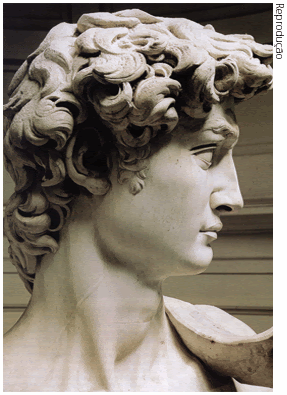 Michelangelo di Lodovico Buonarroti Simoni (Caprese, March 6th, 1475 - Rome, February 18th, 1564) was an Italian Renaissance painter, sculptor, architect, poet and engineer. His versatility in the disciplines he took up was of such a high order that he is often considered a contender for the title of the archetypal Renaissance man.
Michelangelo di Lodovico Buonarroti Simoni (Caprese, March 6th, 1475 - Rome, February 18th, 1564) was an Italian Renaissance painter, sculptor, architect, poet and engineer. His versatility in the disciplines he took up was of such a high order that he is often considered a contender for the title of the archetypal Renaissance man.His David, sculpted from 1501 to 1504, is one of Michelangelo's two greatest works of sculpture, along with the Pietà.
It is the David alone that almost certainly holds the title of the most recognizable statue in the history of art. It has become regarded as a symbol both of strength and youthful human beauty.
 The 5.17 m (17 ft) marble statue portrays the Biblical King David at the moment that he decides to do battle with Goliath. It came to symbolise the Florentine Republic. This interpretation was also encouraged by the original setting of the sculpture outside the Palazzo della Signoria, the seat of civic government in Florence.
The 5.17 m (17 ft) marble statue portrays the Biblical King David at the moment that he decides to do battle with Goliath. It came to symbolise the Florentine Republic. This interpretation was also encouraged by the original setting of the sculpture outside the Palazzo della Signoria, the seat of civic government in Florence.
The completed sculpture was unveiled on September 8th, 1504.
To protect it from damage, the sculpture was moved in 1873 to the Accademia Gallery, and a replica was placed on the Piazza della Signoria in 1910.
Fundamental to Michelangelo's art is his love of male beauty, which attracted him both aesthetically and emotionally. In part, this was an expression of the Renaissance idealization of masculinity, but in Michelangelo's art there is clearly a sensual response to this aesthetic. Such feelings caused him great anguish, and he expressed the struggle between Platonic ideals and carnal desire in his sculpture, drawing and his poetry too, for Michelangelo was also a great lyric poet.
The sculptor's expressions of love have been characterized as both Neoplatonic and openly homoerotic; recent scholarship seeks an interpretation which respects both readings.
One example of the conundrum is the story of the sixteen year old Cecchino dei Bracci, whose death, only a year after their meeting in 1543, inspired the writing of forty eight funeral epigrams, which allude to a relationship that was not only romantic but physical as well:
La carne terra, e qui l'ossa mia, prive
de' lor begli occhi, e del leggiadro aspetto
fan fede a quel ch'i' fu grazia nel letto,
che abbracciava, e' n che l'anima vive.
The flesh now earth, and here my bones,
Bereft of handsome eyes, and jaunty air,
Still loyal are to him I joyed in bed,
Whom I embraced, in whom my soul lives.
The greatest written expression of his love was given to Tommaso dei Cavalieri, who was 23 years old when Michelangelo met him in 1532. Cavalieri was open to the older man's affection: "I swear to return your love. Never have I loved a man more than I love you, never have I wished for a friendship more than I wish for yours." Cavalieri remained devoted to Michelangelo till his death.
Michelangelo dedicated to him over three hundred sonnets and madrigals, constituting the largest sequence of poems composed by him. Their homoerotic nature was recognized in his own time, so that a decorous veil was drawn across them by his grandnephew, who published an edition of the poetry in 1623 – with the gender of pronouns changed…
John Addington Symonds, the early British homosexual activist, undid this change by translating the original sonnets into English and writing a two-volume biography, published in 1893.
The sonnets are the first large sequence of poems in any modern language addressed by one man to another, predating Shakespeare's sonnets to his young friend by a good fifty years.
 Prudishness in the era of advertising?!
Prudishness in the era of advertising?!I feel as lit by fire a cold countenance
That burns me from afar and keeps itself ice-chill;
A strength I feel two shapely arms to fill
Which without motion moves every balance.
Through his poetry and visual art we may glimpse the arc of his imagination…
RIC & Wikipedia
Muito obrigado, Paulo, pela tua estimulante sugestão!
Mais um Setembro que termina.
A uns, «olá, bem-vindos»
A outros, «adeus, até um dia»
Que o mundo não tem como parar…




















20 comentários:
I regret that I was not able to see David when we were in Firenze in 2005. But I just couldn't do everything I wanted to do!
Acho que essa estátua é uma das maiores obras da Renascença, né? Fica difícil até comparar com outras da mesma época.
Viva RIC!!
Acho que David de calções de ganga fica o máximo LOL
Bela homenagem.
Sabes que há uns postais que se compram em Itália, com a legenda: "David (pormenor)"?! São o ideal para mandar com notícias às gentes mais púdicas, rsrsrsrs...
Gostei da intervenção com a ganga, mas eu era capaz de ser mais subversivo - talvez uns acessórios leather, ou umas tangas da Aussie Bum. ;)))
Hello dear Gumby!
How are you?
That's always the trouble when travelling... I also regret having missed so much in all of my journeys abroad... But at least I do know why: I was younger then, I had «other things» in mind... Lol!
But in Florence I did see David twice: the replica on the Piazza and the original inside! Great moments!
I wish you the best! :-)
Olá Leo!
Também acho muito difícil qualquer comparação. Ainda que os temas e os estilos sejam diferentes, há três outras aproximadamente da mesma época que nunca esqueço: as duas «Pietà» (Roma e Bruges) e «O Êxtase de Santa Teresa de Ávila» - todas fabulosas!
Abração! :-)
Viva Teddy Bear!
Eu também achei! Rsrsrs! Por isso achei que devia pô-lo aqui também como «prova» da intemporalidade da arte superior! Fica delicioso assim vestidinho, não fica?... Rsrsrs! Bem mais sensual! Rsrs!
Um abraço, meu caro! :-)
Olá João!
Muito obrigado! Já ia sendo tempo de dar algum destaque àquele que me tem emprestado a cara aqui na blogosfera!... Rsrs!
Imagino o pormenor!... Rsrsrs! Se o rapazinho tem 5,17 m de altura e é todo ele tão classicamente proporcionado... É melhor parar já com as contas! Rsrsrs! Excelente ideia, a dos postais!
Concordo contigo! Lamentavelmente, nada sei de Photoshop, pelo que não posso aventurar-me nessas empresas... Rsrs! Tive de me contentar com o que encontrei... Mas a hipótese «Aussie Bum» é extremamente sedutora!... Rsrsrs!
Tenho de aprender a «photoshopar»!
Rsrsrs!
Um abraço, meu caro! :-)
Olá Ricardo não tens nada que agradecer é uma obra magnífica e não fica nada mal em calções. Ainda assim prefiro a original com tudo ao léu.
É realmente um monumento à beleza masculina, perfeito.
Confesso que não conhecia o talento de Michelangelo para a poesia mas sendo ele um homem da renascença não me surpreende.
Um abraço
Gostei de saber um pouco mais s/ David. Posso dizer que fiquei a conhecer um pouco mais da tua cara, aqui na blogosfera. :-)
Imponente o «piqueno»! ...e de calção de ganga, fica um must! (Hoje as fotos não passaram despercebidas).
Como bem dizes no final do «post», Setembro terminou. Entrámos no último trimestre do ano...e «cheira-me» a mudança(s).
Beijinho :-)
( Pitágoras poderia vir ao tal convívio assim de calções...ok, ok...Era só uma ideia.Rs! )
Olá meu caro Paulo!
Sabes bem que foste tu quem me sugeriu este «eye candy» histórico! Assim, um agradecimento é de regra, não? Rsrs!
Também achei que os calções lhe dão um toque muito contemporâneo, embora também prefira vê-lo como o vi em Florença... Rsrs!
Quanto à poesia, também estou entusiasmado e goataria de ler muito mais, mas receio que o meu Italiano «de viagem» não dê, nem de perto nem de longe, para ler poesia clássica... Seria como querer ler a lírica de Camões sem saber Português de jeito...
Um abraço também para ti! :-)
Olá querida Susana!
Bem, se ficaste a conhecer um pouco mais da minha blogosférica cara, tenho as minhas dúvidas... Rsrs!!! Mas isso agora não interessa nada... Rsrs!!!
Pois não! Mesmo tratando-se da mais séria Arte do Renascimento, não deixa por isso de ter um cheirinho a «eye candy»... Daí, todas as referências e mais alguma! Rsrsrs!!!
Quanto às mudanças, concordo contigo. Terminada a «rentrée», é tempo de «set some things right». E eu não gosto nada de situações adiadas...
Bem!... Pitágoras de calções a demonstrar o seu teorema... Talvez... Rsrs! Mas eu acho a túnica grega bem mais sensual! Mera opinião, concordo... Rsrs!
Um beijinho também para ti! :-)
a GREAT post.
Nice music tonight, too
Hello dear Will!
Thank you so very much!
Boccherini's music has to do with the latest post, as you've noticed.
Best wishes! :-)
We had an Atty.General in Bush's 1st term who ordered naked statyes be covered at the department of Justice. The David in pants is not too far off from reality it seems.
... Oh my God! That's all the more incredible since in Europe Renaissance naked statues were covered only until the 17th century! At least, this is what I've read about that matter.
As to the David in pants, that's obviously a commercial stunt, and that photo was «photoshopped» as could be...
Cheers!
Indubitavelmente, a estátua mais reconhecida em todo o mundo. Quase a par, a Vénus de Milo... quase.
Valeu, Ric, valeu mesmo!
jocas
;)
Olá querida Graça!
É, sem dúvida, mas a Vénus de Milo ou a Vitória de Samotrácia são «doutro departamento»: essas senhoras são genuinamente clássicas, enquanto o David é renascentista... Cerca de 2000 anos de diferença é obra! Rsrs!
Ainda bem que gostaste! Fico contente!
Beijinhos! :-)
Exactamente, Ric. Essa é a prova cabal de que a antiguidade NÂO é um posto.
:)
(por acaso já me tinha esquecido da Vitória de Samotrácia, sempre que evoco a escultura da antiguidade clássica - a minha época favorita em termos de estudo - só me lembro da Vénus e da Afrodite)
jocas grandes
Pois não, querida Graça, não é posto MESMO! Mas ainda há quem se... confunda... Rsrs!
Sempre gostei muito da Vitória por toda aquela leveza, pelo ser esvoaçante que parece ser.
Beijinho! :-)
Enviar um comentário